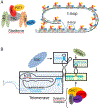Telomere biology disorders: time for moving towards the clinic?
- PMID: 36057525
- PMCID: PMC9509473
- DOI: 10.1016/j.molmed.2022.08.001
Telomere biology disorders: time for moving towards the clinic?
Abstract
Telomere biology disorders (TBDs) are a group of rare diseases caused by mutations that impair telomere maintenance. Mutations that cause reduced levels of TERC/hTR, the telomerase RNA component, are found in most TBD patients and include loss-of-function mutations in hTR itself, in hTR-binding proteins [NOP10, NHP2, NAF1, ZCCHC8, and dyskerin (DKC1)], and in proteins required for hTR processing (PARN). These patients show diverse clinical presentations that most commonly include bone marrow failure (BMF)/aplastic anemia (AA), pulmonary fibrosis, and liver cirrhosis. There are no curative therapies for TBD patients. An understanding of hTR biogenesis, maturation, and degradation has identified pathways and pharmacological agents targeting the poly(A) polymerase PAPD5, which adds 3'-oligoadenosine tails to hTR to promote hTR degradation, and TGS1, which modifies the 5'-cap structure of hTR to enhance degradation, as possible therapeutic approaches. Critical next steps will be clinical trials to establish the effectiveness and potential side effects of these compounds in TBD patients.
Keywords: PAPD5; RNA processing; bone marrow failure; liver fibrosis,; pulmonary fibrosis; telomerase; telomere shortening.
Copyright © 2022 The Authors. Published by Elsevier Ltd.. All rights reserved.
Conflict of interest statement
Declaration of interests R.P. is a founder and consultant for Faze Medicines. The other authors declare no conflicts of interest.
Figures


Similar articles
-
Posttranscriptional modulation of TERC by PAPD5 inhibition rescues hematopoietic development in dyskeratosis congenita.Blood. 2019 Mar 21;133(12):1308-1312. doi: 10.1182/blood-2018-11-885368. Epub 2019 Feb 6. Blood. 2019. PMID: 30728146 Free PMC article.
-
Inhibition of telomerase RNA decay rescues telomerase deficiency caused by dyskerin or PARN defects.Nat Struct Mol Biol. 2016 Apr;23(4):286-92. doi: 10.1038/nsmb.3184. Epub 2016 Mar 7. Nat Struct Mol Biol. 2016. PMID: 26950371 Free PMC article.
-
Dyskeratosis congenita mutations in dyskerin SUMOylation consensus sites lead to impaired telomerase RNA accumulation and telomere defects.Hum Mol Genet. 2013 Sep 1;22(17):3498-507. doi: 10.1093/hmg/ddt204. Epub 2013 May 8. Hum Mol Genet. 2013. PMID: 23660516
-
Dyskeratosis congenita: the diverse clinical presentation of mutations in the telomerase complex.Biochimie. 2008 Jan;90(1):122-30. doi: 10.1016/j.biochi.2007.07.017. Epub 2007 Jul 31. Biochimie. 2008. PMID: 17825470 Review.
-
The molecular genetics of the telomere biology disorders.RNA Biol. 2016 Aug 2;13(8):696-706. doi: 10.1080/15476286.2015.1094596. Epub 2015 Sep 23. RNA Biol. 2016. PMID: 26400640 Free PMC article. Review.
Cited by
-
ZCCHC8 p.P410A disrupts nucleocytoplasmic localization, promoting idiopathic pulmonary fibrosis and chronic obstructive pulmonary disease.Mol Med. 2024 Sep 10;30(1):144. doi: 10.1186/s10020-024-00913-9. Mol Med. 2024. PMID: 39256642 Free PMC article.
-
Aging-associated atrial fibrillation: A comprehensive review focusing on the potential mechanisms.Aging Cell. 2024 Oct;23(10):e14309. doi: 10.1111/acel.14309. Epub 2024 Aug 12. Aging Cell. 2024. PMID: 39135295 Free PMC article. Review.
References
Publication types
MeSH terms
Substances
Grants and funding
LinkOut - more resources
Full Text Sources
Miscellaneous

